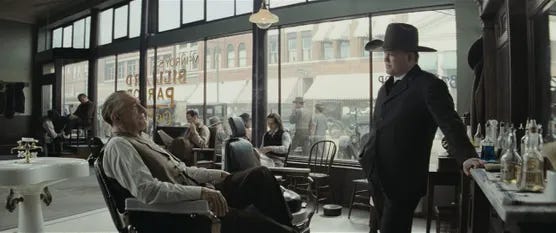I’m just grateful I got to see another monumental film of Marty’s on the big screen. With the new releases of only a few select filmmakers including him, it always feels like a different, special experience compared to anything else that comes out now.
Killers of the Flower Moon is very matter-of-fact in many ways but is anything but flat and always feels distinctly Scorsese. It’s not that Scorsese has a flashy style but you can always tell he’s behind the camera because of his awareness of multiple perspectives in history and concentration on the relationships between those on screen. He cares so deeply about telling the stories of the characters in this film and focuses so intimately on their stories. The layered, brutally honest drama takes center stage and the overwhelming runtime feels wholly necessary, as it did in The Irishman.
As an outsider looking in on the Osage nation, you question the characters’ morals from the opening scene until the credits roll. When the film ends, you’re not left empty after watching these slimeballs get away with their crimes. Instead, through the tremendous agency Scorsese gives to the natives, you truly feel connected to the victims. And that’s the goal in the end: we can’t give these natives back what they lost but we can give them back their voice. History can’t be changed but you can at least look at the situation in the most human way possible, on both sides.
Leonardo DiCaprio, as fresh-out-of-the-Army Ernest Burkhart, went to a place I’ve never seen him go. He plays Burkhart as someone who feels displaced in his own body to the point of feeling like a puppet at times (not to say he wasn’t responsible for what he did). In Django Unchained, DiCaprio is certainly intimidating but Tarantino’s touch made Calvin Candie a bit too cartoonish and theatrical to get a true feeling of how far into a realistic villainous role DiCaprio can go. Here, he gives one of his best performances to date, constantly making you uncomfortable with how he’s simultaneously lost in his ways but also fully content in his actions (which is admittedly debatable in some respects, especially after the ending). The greedy two-faced rancher, William “King” Hale, played by Robert De Niro, feels off from the start and is just as believable. Scorsese takes his time to reveal Hale’s manipulation and while we may not have ever completely trusted Hale without blinking twice, we feel convinced to a certain degree of how he has “benefitted” the lives of the Osage.
One of the most difficult parts to pull off was the balance of focusing on the white Burkhart and Hale, while not taking away from the Osage themselves. And even though the movie becomes increasingly focused on DiCaprio’s Ernest and less so on Lily Gladstone’s Mollie — at least directly — we’re always conscious of where our sympathy should lie. By having a structure that flows at a fairly consistent pace, the quick outbursts of violence are even more jarring and hard-hitting. This choice can be a gamble when the movie is already as long as it is, but Scorsese knows that he needs to take all the time necessary to say what needs to be said.
The epilogue is fantastic and all I have left to say is: keep working, Marty!
10/20/23






